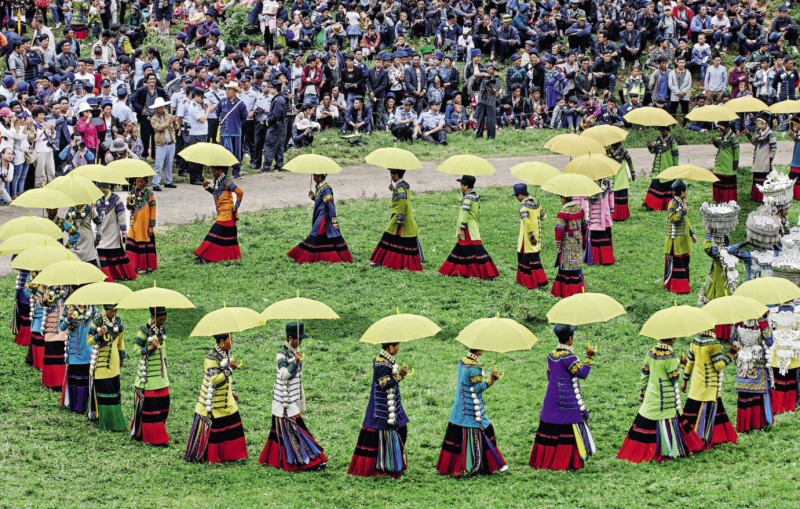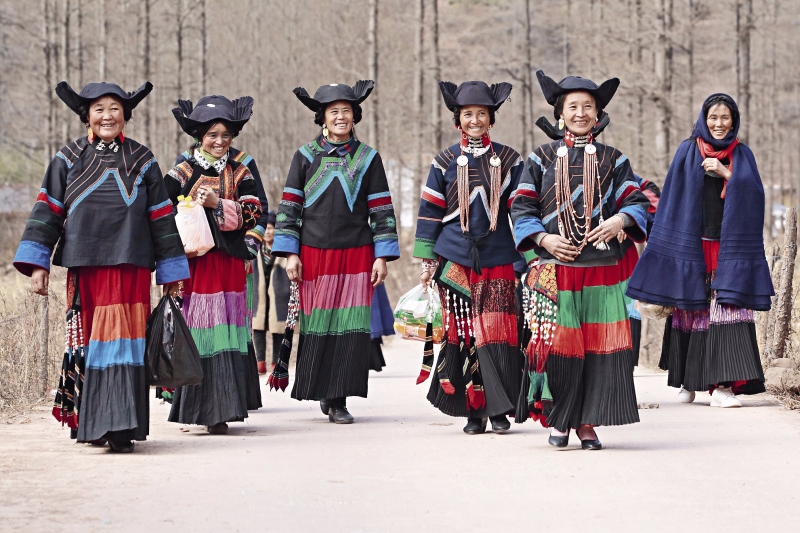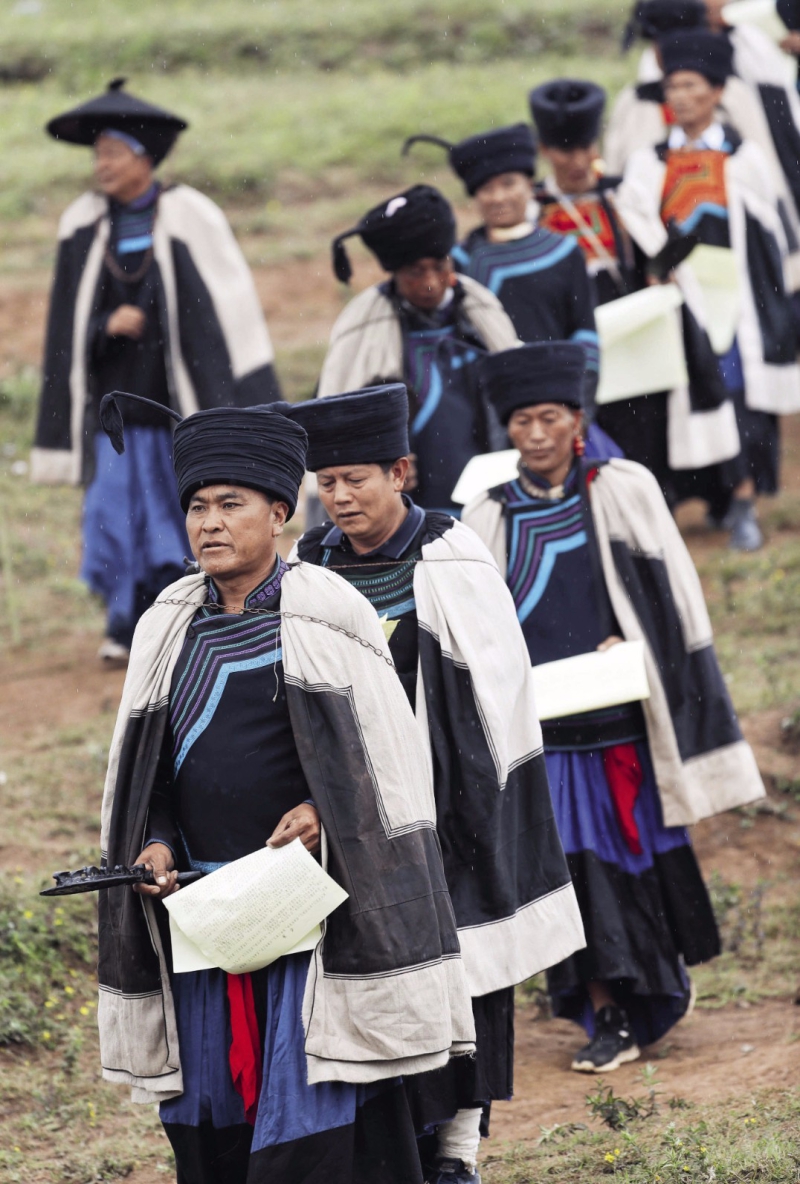THE Yi ethnic group has a long history. The Yi people have lived in the belt between plateaus and coastal hills in Yunnan, Sichuan, Guizhou, and Guangxi Zhuang Autonomous Region for many of those years. An important part of their culture is their gorgeous traditional costumes, which reflect the diversity of this ethnic group, and the unique features of the region.
The Torchlight Festival of Yi people in Butuo County, Liangshan Yi Autonomous Prefecture, Sichuan Province kicks off, and puts on a beautiful fashion show on July 22, 2016.
Yi costumes are rich in color and styles, and people like to use silver and embroidery as decorations. The styles of Yi costumes vary from place to place. Among them, the costumes in Liangshan Yi Autonomous Prefecture are the most representative. Men’s clothes are plain but present dignified bearing, whereas women’s are colorful and exquisite. In addition, the costumes differ depending on gender, age, identity, occasion, and other factors. In general, young people prefer bright colors, while the elderly care more about comfortableness.
Yi men keep a lock of hair on their head, which is called the “Buddha Lock.” This ancient tradition symbolizes men’s dignity and holiness. The headdress for men is called a “hero knot,” which is a 20- to 30-cm-long column-like bundle wrapped with a dark blue or black cloth around the head. The bundle usually points diagonally towards the sky. “Hero knots” represent the unyielding spirit of Yi men. The shape of the knot varies by age.
Unmarried young women wear tile-shaped headdresses made from blue cloth. Young girls fix the headdress with braids and red cord and decorate it with hairpins and combs. Married women, after getting pregnant or childbirth, wear a black “lotus leaf hat,” also known as the “big eagle hat.” Those who still choose to wear young girl’s headdress will be considered as lacking manners.
The traditional clothing of the Yi in Liangshan is mainly made from woolen and linen fabric dyed preferably in black, red, and yellow. When making clothes, the commonly used techniques include picking, embroidering, and inlaying, and the patterns of curved blade, sheep’s horn, and plant are used as exquisite decorations. Both men and women like to wear a kind of blouse called a ca’erwa. This blouse is made of white, grey, and green wool, some with a fringe, some without, coming in a variety of patterns that include checks, twill, ripple, and pumpkin seed.
A group of Yi women in traditional clothes returning home in high spirits from a relative’s wedding on December 27, 2017, in Meigu County, Liangshan Yi Autonomous Prefecture, Si-chuan Province.
Because of the differences of local dialects, the style of dress among the Yi people in Liangshan differs. Generally, the place has three clothing style areas according to dialects. One is the Yinuo dialect clothing area, which favors wide-leg trousers for men’s clothes. The representative area is Meigu County. The second one is the Shengzha dialect clothing area, represented by Xide County. The third is the Suodi dialect clothing area, where people prefer narrower-leg trousers. The representative area is Butuo County.
Males of the Yinuo dialect dress area prefer simple clothing. Adult men like to wear a navy blue or blue headdress, and collarless tops often embroidered with a variety of exquisite patterns. Trousers have wide legs and are bound with leggings. A dagger is worn at the waist and a musk bag hangs over the chest. The lower edge of the ca’erwa is often decorated with a black cloth about 30 cm wide. The color of middle-aged and older people’s clothing is generally simple, mostly black and white. Children often wear hats embroidered with tigers, cats, or other animal patterns, and like to wear copper bracelets to ward off evil spirits. Women’s wear should reflect their age. The top of young women’s clothing is tight and attractive. The lower part of the body is covered with pleated skirts in red, yellow, green, and other bright colors. The skirt belt is adorned with purses featuring exquisite patterns and fringes. They also have bamboo string boxes or needle boxes hung over the chest. The headdress is blue or black. Middle-aged and older women’s clothing emphasizes simplicity and elegant colors.
People of the Shengzha dialect dress area mostly wear white, black, and blue ca’erwas. Young men wear a shirt, a waistcoat, and a collarless and right-lapel jacket. The jacket is made in a simple style, and has tight and snug-fitting sleeves as well as decorations of colored cloth around the shoulders, lapel, and hem. Middle-aged and old men’s jackets are relatively loose fitting and generally have no decorations. For the lower body, they wear pants, with trouser legs that are tighter than the Yinuo dialect area. Young women’s jackets feature snug-fitting sleeves, are knee length and decorated with snow white rabbit fur. The headdress is light and delicate, with exquisite patterns embroidered on it.
A group of Yi people celebrate the wool cutting festival on July 20, 2019, in Liangshan, Si-chuan Province.
The men’s wear in the Suodi dialect community is mostly made of black cloth. The top is tight and short, which often exposes the navel. The top is inlaid with long rows of silver buttons, and the hems are inlaid with yellow and red strips for decoration. Trousers are characterized by a loose fitting waist and narrow bottoms of the trousers legs. They are often decorated with a sun pattern at the crotch center. Women usually wear a smock decorated with traditional rippling patterns outside the jacket. Skirts are made of wool, with pleats at the feet and fewer pleats further up. On their heads, ladies wear navy blue head-handkerchiefs with laces, and sometimes a yak felt hat.
In terms of ornaments, there are some differences in each dialect group. Generally speaking, men’s earrings are usually three agate beads in red alternating with yellow or wax beads. Sometimes the earrings are decorated with black tassels. Silver rings are also common male earrings. Women wear jewelry of gold, silver, coral, jade, and other materials. They particularly value neck jewelry, mostly being silver collars. Children often wear silver, copper or wood locks around the necks, which are said to help the wearer avoid evil spirits and seek peace. Adult men like to wear daggers or waist knives. They also wear swords on important occasions, such as sacrificial rituals.
The colorful costumes of the Yi ethnic group in Liangshan show the ancient ethnic culture of the Yi people, reflect their unique aesthetic psychology and cultural customs, and are part of the treasure of Chinese culture.
_______________
GUO ZHIDONG is a researcher of traditional culture course in No.93 Courtyard Museum.


